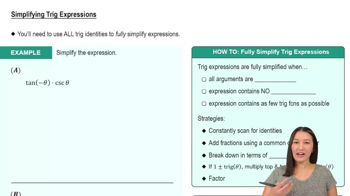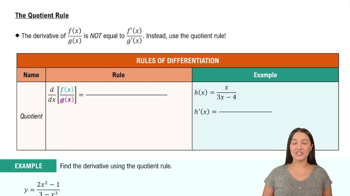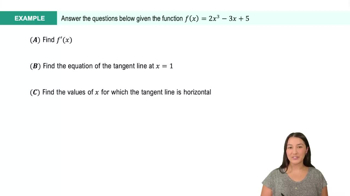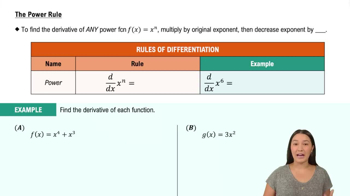Table of contents
- 0. Functions7h 52m
- Introduction to Functions16m
- Piecewise Functions10m
- Properties of Functions9m
- Common Functions1h 8m
- Transformations5m
- Combining Functions27m
- Exponent rules32m
- Exponential Functions28m
- Logarithmic Functions24m
- Properties of Logarithms34m
- Exponential & Logarithmic Equations35m
- Introduction to Trigonometric Functions38m
- Graphs of Trigonometric Functions44m
- Trigonometric Identities47m
- Inverse Trigonometric Functions48m
- 1. Limits and Continuity2h 2m
- 2. Intro to Derivatives1h 33m
- 3. Techniques of Differentiation3h 18m
- 4. Applications of Derivatives2h 38m
- 5. Graphical Applications of Derivatives6h 2m
- 6. Derivatives of Inverse, Exponential, & Logarithmic Functions2h 37m
- 7. Antiderivatives & Indefinite Integrals1h 26m
- 8. Definite Integrals4h 44m
- 9. Graphical Applications of Integrals2h 27m
- 10. Physics Applications of Integrals 2h 22m
3. Techniques of Differentiation
Basic Rules of Differentiation
Problem 3.3.56
Textbook Question
Find the derivative of the following functions by first expanding or simplifying the expression. Simplify your answers.
y = (x2 - 2ax + a2) / (x - a); a is a constant.
 Verified step by step guidance
Verified step by step guidance1
Step 1: Recognize that the function y = \frac{x^2 - 2ax + a^2}{x - a} is a rational function, which can be simplified by performing polynomial long division or by recognizing it as a special form.
Step 2: Notice that the numerator x^2 - 2ax + a^2 can be rewritten as (x - a)^2 by recognizing it as a perfect square trinomial.
Step 3: Simplify the expression by canceling the common factor (x - a) in the numerator and the denominator, resulting in y = x - a.
Step 4: Differentiate the simplified function y = x - a with respect to x. Since a is a constant, the derivative of a constant is zero.
Step 5: Apply the basic differentiation rule: the derivative of x with respect to x is 1. Therefore, the derivative of y = x - a is y' = 1.
 Verified video answer for a similar problem:
Verified video answer for a similar problem:This video solution was recommended by our tutors as helpful for the problem above
Video duration:
4mPlay a video:
Was this helpful?
Key Concepts
Here are the essential concepts you must grasp in order to answer the question correctly.
Derivative
The derivative of a function measures how the function's output value changes as its input value changes. It is defined as the limit of the average rate of change of the function over an interval as the interval approaches zero. In calculus, the derivative is often denoted as f'(x) or dy/dx, and it provides critical information about the function's behavior, such as its slope and points of tangency.
Recommended video:

Derivatives
Simplification of Expressions
Simplifying an expression involves rewriting it in a more manageable or understandable form, often by combining like terms, factoring, or reducing fractions. In the context of calculus, simplifying an expression before taking the derivative can make the differentiation process easier and help avoid errors. For example, factoring polynomials or canceling common terms can lead to a clearer function to differentiate.
Recommended video:

Simplifying Trig Expressions
Quotient Rule
The quotient rule is a method for finding the derivative of a function that is the ratio of two other functions. If y = u/v, where u and v are functions of x, the derivative is given by y' = (v * u' - u * v') / v^2. This rule is essential when dealing with functions that are expressed as fractions, as it allows for the correct application of differentiation to both the numerator and denominator.
Recommended video:

The Quotient Rule

 3:59m
3:59mWatch next
Master Derivatives of Linear Functions with a bite sized video explanation from Callie
Start learningRelated Videos
Related Practice







